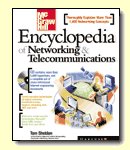|
Site home page
(news and notices)
Get alerts when Linktionary
is updated
Book updates and addendums

Get info about the Encyclopedia of Networking
and Telecommunicatons, 3rd edition (2001)

Download the electronic version of the Encyclopedia
of Networking, 2nd edition (1996). It's free!
Contribute to this site
Electronic licensing info
|
|
Name Services
Related Entries Web Links New/Updated Information
Note: Many topics at this site are reduced versions of the text in "The Encyclopedia of Networking and Telecommunications." Search results will not be as extensive as a search of the book's CD-ROM.
A name service, or resolver service, allows people to use user-friendly names when working on network-attached computers and accessing network resources. A name is easy to remember. In the background, most networks use numeric addressing schemes or other schemes to identify hosts and resources. Naming services translate a name in one form to an identification in another form. The following describes a variety of naming/resolver services. Some offer basic name/address translation while others offer services to help people find documents and other resources on networks.
- DNS (Domain Name System)
DNS is the most common naming service. It resolves names into IP addresses and is used throughout the Internet. When you access a Web site such as http://www.linktionary.com, the name is first sent to a DNS server, usually at your ISP, that resolves the name into the IP address for the site. The IP address is then used for all further requests. See "DNS (Domain Name Service) and Internet Domains."
- NetBIOS Naming
NetBIOS is a networking protocol originally developed by Microsoft and IBM for local area networks. Computers and other resources are assigned names, and all the computers on the network work together to keep track of the names on the local network. This LAN scheme can't be used on router-connected internetworks, not only because it is not designed to cross routers, but also because you don't want every computer on a large internetwork to keep track of every other computer. See "NetBIOS/NetBEUI."
- The CCSO Nameserver (Ph)
The Ph Nameserver from the Computing and Communications Services Office (CCSO), University of Illinois at Urbana-Champaign provides a white pages directory service for locating people. RFC 2258 (The Internet Nomenclator Project, January 1998), RFC 2259 (Simple Nomenclator Query Protocol, January 1998), and RFC 2378 (The CCSO Nameserver Architecture, September 1998) provide additional information.
- WHOIS
A search and retrieval service for locating users on a network. The protocol was originally used to access a central NICNAME database maintained by the Network Information Center (NIC). This database allowed online lookup of individuals, network organizations, host machines, and other information. See "WHOIS ("Who Is")" for more information.
- NIS (Network Information Service)
This is a distributed database that provides a repository for storing information about hosts, users, and mailboxes in the UNIX environment so that users can easily locate those objects and resources. It was originally developed by Sun Microsystems and called YP (Yellow Pages). See "NIS (Network Information System)."
- Handle System
The Handle System is a global naming service for documents. It provides document persistence, meaning that documents can be found by name, even if their original location is moved. The strategy uniquely identifies documents and stores the information in a name server along with the current location of the document. If the document is moved, the location information is updated. When users need a document, they obtain the current location in a Handle server. See "Handle System" for more details.
- URN (Uniform Resource Names)
Like the Handle System, this IETF development assigns names to objects that are independent of their location. For example, the handle urn:isbn:0078823331 identifies a book. When a user want to access information about the book, a request is made to a resolution server, which looks in the namespace called "isbn" to find a book called 0078823331. The server then returns the current URLs. If the URL changes, the name servers are automatically updated so that users can always find the book. See "URN (Uniform Resource Name)."
- CNRP (Common Name Resolution Protocol)
An Internet protocol that relieves people from having to remember long and complicated Internet URL (Universal Resource Locators). Instead, you type in "common names" to access resources. CNRP provides a "resolution service" that converts the common name into an Internet address. See "CNRP (Common Name Resolution Protocol)."
Note that directory services such as NDS (Novell Directory Service) and Microsoft Active Directory offer many of the features described in these services. See "Directory Services" and "LDAP (Lightweight Directory Access Protocol)" for more information.
RFC 2151 (A Primer On Internet and TCP/IP Tools and Utilities, June 1997) provides a discussion of Internet tools related to naming, searching, indexing, and so on.
Advertising services are related to naming services. They offer a different approach to finding resources and services on a network. The basic idea is that devices with services to offer either broadcast messages that advertise the services they offer (which is inefficient) or listen for messages from clients that are requesting services. See "Service Advertising and Discovery" for more information.
Copyright (c) 2001 Tom Sheldon and Big Sur Multimedia.
All rights reserved under Pan American and International copyright conventions.

|

